M.6(1) – Fan Cart
The fan cart can be used to demonstrate the effect on propulsion when a 45° sail introduces a new component of force. Without its sail in place, the cart moves along a smooth, leveled surface. When the sail is set parallel to the air flow it does not move; if you adjust the sail’s angle with respect to the “wind,” the cart moves at different speeds, to different directions.
The fan cart also demonstrates uniform acceleration.
Dimensions: 30 cm in length with a 25 cm x 25 cm sail.

M.6(2) – Paradox of Forces
This demonstration illustrates equilibrium of static forces as well as Newton’s Third Law. The set-up consists of a spring scale connected through pulleys to 1 kg masses hanging on each side. First, a 1 kg mass is suspended from the spring scale and the needle position noted for the class. The spring scale is now laid across the table with 1 kg attached to each side. The students are then asked to guess the reading on the spring scale. The scale can then be tipped sideways to show that it reads exaclty the same as before.
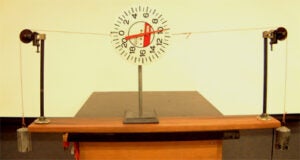
M.6(3) – Reaction Carts
Various sets of dynamics carts are available: all of them are about 20 cm long and 500 grams in mass, with low-friction ball-bearing wheels. In one set the carts have strong horse-shoe magnets attached to them. All the others have built-in spring plungers. The carts can be held together by a string loop or hook and loop fasteners. Burning this string loop or activating the trigger button, launches each cart in opposite directions. Different masses can be added to the carts to observe the different reactions.

M.6(4) – Magnets on a Balance
Two ring magnets are balanced against a weight. Equilibrium is maintained, regardless of the orientation of the magnets: they can be set floating on each other’s fields, repelling or attracting.
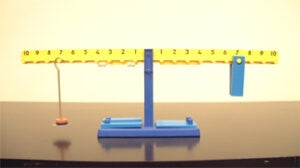
M.6(5a) – Hero’s Jet Engine
This apparatus illustrates the earliest known form of steam engine. Apart from its historical interest, it is a useful demonstration of jet propulsion, showing Newton’s Third law of motion, in action. It consists of a 10 cm stopped glass bulb with jet arms extending at opposite sides. The bottle is fastened with a rubber stopper and a rod attached to a bearing wheel, so that it is free to rotate under the reaction forces of the steam jets emanating from both sides. The flask has a little water, and is mounted by its supporting rod to a stable stand. Bring the gas burner underneath it. When the steam pressure is sufficient for the flask to begin to spin, turn the flame down somewhat. The flask will continue to spin until the pressure has diminished.
NOTE : Do not overheat it.
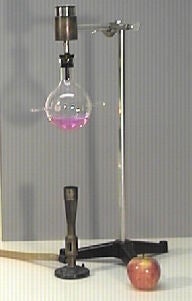
M.6(5b) Cryo Jet Engine
This demo operates under the same principles as the Hero’s Jet Engine demo (M.6(5b)), but with liquid nitrogen used in the spinning container instead of water. A plastic bottle is used as the container instead of glass flask in order to avoid fracturing and breaking from thermal stress.
Click here to see a video of this demo.
M.6(6) – CO2 Rocket – The Rocket Propulsion Demonstrator
The demonstration includes a counterweighted metal crossbar which rests on a vertical support rod mounted on a sturdy base. A CO2 cartridge is inserted in the holder at one end of the crossbar and the spring loaded pin is used as a firing device. When the cartridge is punctured, the release of CO2 gas propels the crossbar around, simulating rocket flight and demonstrating that for every action there is an equal and opposite reaction.

M.6(7) – Jet Propulsion Demonstrator
A volunteer, sitting on a large cart, holds a fire extinguisher and activates it. The fire extinguisher works as an engine moving the cart across the room.
NOTE : Extra care is needed when handling the fire extinguisher’s hose, because it can be extremly cold and there is a possibility of electrostatic shock.
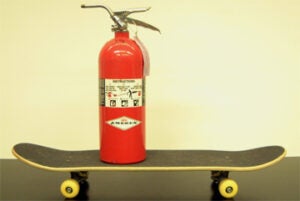
Click here to see the Jet Propulsion Demonstrator in action!
M.6(8) – CO2 Car racing Experiment
This experiment demonstrates conservation of momentum. Equivalently, it exemplifies the concept of action-reaction forces between the cars and the released CO2. When the lever of the launch pod is pressed down, a hole is punched in the CO2-cartridge of each car at rest. The liquid CO2 starts boiling and is ejected from the nozzle with a large momentum. By conservation of momentum of the system ‘car + CO2’, the car is launched with an equal momentum in the opposite direction.
Because of the cars’ high speeds, a foam block is needed to safely decelerate them.
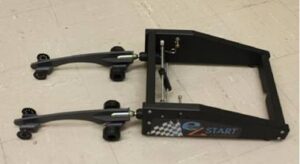
Click here to see a video of this demo.
M.6(9) – Smoke Cannon
This demo consists of compressible cannon (21” x 26”) and a fog machine. The cannon is first filled with smoke from a fog machine. When the back end of the cannon is struck sharply, a sudden increase in pressure inside forces a “ball” of air to shoot out of the circular opening (6” in diameter) in front.
Since the air being expelled from the cannon is dragged by the edges of the hole, the air expelled from the center moves faster than the air near the edge, causing the air from the sides to be sucked in toward the center and a doughnut-shaped vortex forms. The ring-like shape is maintained due to the rotational motion of the air.
The smoke cannon demo utilizes a “Chauvet Hurricane 900” 650-watt fog machine which has a 1.3-liter tank capacity for the fog fluid (fog fuel) and requires about 5 minutes to warm up. The fog machine can be operated either directly or via a wired remote.
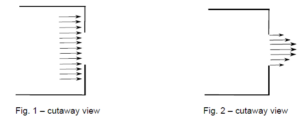
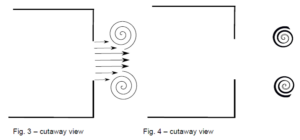

Click here to see a video of the Smoke Cannon demo at work.
M.6(10) – Ping Pong Ball Liquid Nitrogen Demo
For this demo approximately 100 colored ping pong balls placed in a white pail. For safety reasons, the pail is then placed in a shatterproof plexiglass container. Small quantity of liquid nitrogen is poured into a plastic water bottle and then sealed. Then the pressure of cold, trapped nitrogen is placed in the bucket with the ping pong balls. After a short period of time, the liquefied gas expands causing the water bottle to burst and the ping pong balls hurled into the air.


Note: 48 hour notice required for setup